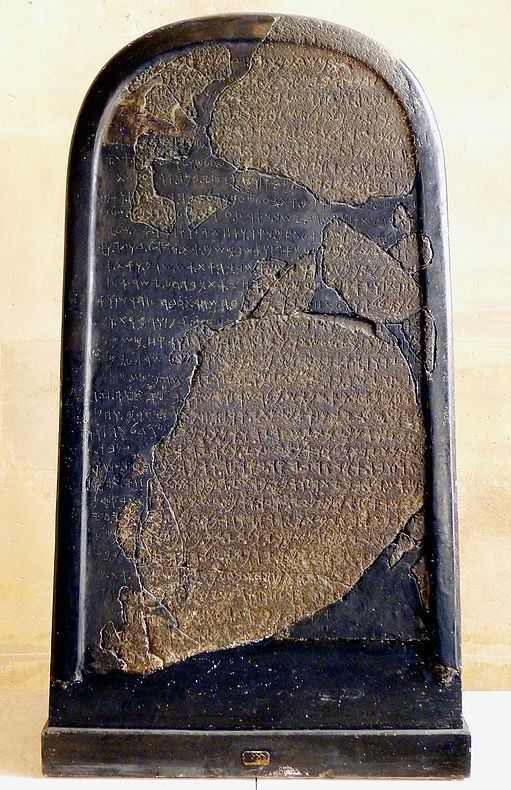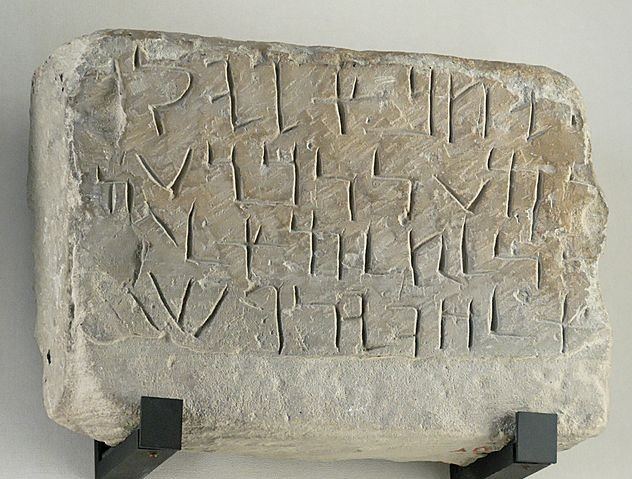
[If you want to learn Biblical Hebrew you can read here my review on how to do this.]
The First Record of Hebrew
So how far back does the Hebrew language date? The origin of the Hebrew language dates back to the second millennium BCE. We see evidence of this in the Moabite Stone. The Moabite Stone, also known as the Mesha Stele, is an inscribed stone that King Mesha set up around 840 BCE, which tells the tale of the Moabite victory over the son of King Omri of Israel. The text written on the stone is written in the Moabite language which is a Semitic language like the Hebrew language. This is our first look at how the Hebrew language was formed.
Early Hebrew
When the Israelite tribes established in Canaan in 14th and 13th centuries, they wrote and spoke Hebrew until the occupation of Jerusalem in 587 BCE. When Hebrew first appears in document form there is clear evidence that the language belongs to the Canaanite group of languages. Because of this, it is believed that when Israelites tribes came to Canaan they took the Canaan language and adopted it, at least, into their written documents.
Early Hebrew was the script used by the Jewish nation even when Israel split into two kingdoms. The two kingdoms were Israel in the north and Juda in the south. This language was spoken in both of those two kingdoms until the Babylonian Exile which took place in 597 BCE when Babylon conquered the southern kingdom of Judah. This script was eventually replaced with the Hebrew square script that was created with influence from Aramaic square script at the end of the 6th century BCE.
Early Hebrew is considered to be the language which people used during the First Temple period. And during this time, 1006-587 BCE, it is possible that there existed a difference between the written and spoken language. But despite this, Hebrew was both written and spoken in everyday life. It wasn’t until the exile when the Hebrew language disappeared from everyday life.
 Biblical Hebrew
Biblical Hebrew
Because the Hebrew language began to disappear as a spoken language once the Jews were exiled, a formal written Hebrew language was used in important texts and the Biblical Hebrew was born. The Biblical Hebrew or Classic Hebrew as some call it, was adopted by the Jews during the Babylonian captivity.
During the period of the Second Temple, 515 BCE-70CE, Hebrew was used only for literary and liturgical goals. Because this language was used in books of the Bible, on the one hand, and the Dead Sea Scrolls, on the other hand, it is believed that Biblical Hebrew is not a real language in the complete sense of the word but instead a “fragment of language” and only part of this language was actually used prior to the exile. There are only 8,000 language items in the Bible, and that could have not been sufficient to create a real language.
The Aramaic square characters are the official script that was chosen and is seen on the Torah scrolls in the 5th century BCE. This classic Hebrew script has remained unchanged to this day.
As the Biblical Hebrew language is the language in which literature was created and administration functioned, it is possible that the spoken language even prior to the exile could have resembled more closely to Mishnaic or Rabbinic Hebrew. This is because there are notable differences between how Hebrew was written for the Bible verse or how it was written in poetry. Biblical Hebrew being of the more formal and Mishnaic Hebrew being of the more informal.
Mishnaic Hebrew
In about 200 CE Mishnaic or Rabbinic Hebrew was written. This form of Hebrew was an assemblage of Jewish traditions. Also, there is another form, called Mishnaic Hebrew proper, or Mishnaic Hebrew I, that people used as a spoken language. During the early part of Mishnaic Hebrew I, some of the Biblical Hebrew consonants were confused or combined with one another. And many words, especially nouns, were adopted from Aramaic. The same is true for other Latin, Persian and Greek words.
Because of these borrowed words, vocabulary and grammar are quite different from written Biblical Hebrew as well as written early Hebrew. We see evidence of this when looking at the Bar-Kokhba letters. The Bar-Kokhba letters were written during the Rebellion or as some call it the Third Jewish-Roman War. They were written by Simon Ben Kosiba who was a leader of the last resistance against the Romans who also spoke Mishnaic Hebrew I. Sadly when the Jews were defeated by the Romans most “native speakers” were murdered and the Mishnaic Hebrew I was lost as a verbal language.
Medieval Hebrew
It’s no surprise that after Mishnaic Hebrew I, which was lost as a language in use, there was a decline in Hebrew being a spoken language from the 9th century until the 18th century. But this doesn’t mean nothing happened in the spoken Hebrew language. During this time the medieval language knew some development.
In the 6th – 9th-century piyyῦt, a Jewish liturgical poem, had a strong following. Because of the popularity of this poetry fresh meaning was given to old words through writing. This was mostly present in Kalirian style and Spanish Hebrew poems. In this period about 2,000 to 3,000 terms were added. These terms were largely philological, scientific, and philosophical.
Some of these words were created by using the roots of already existing Hebrew words, while others were adapted from other languages such as Greek and Arabic. As this form of Hebrew was spoken, and more words were adapted from other languages, new languages were formed and spoken in the Jewish communities. One of those languages being Yiddish and one being Ladino.
Yiddish is a combination of the Hebrew and German languages, while Ladino is a combination of the Hebrew and Spanish languages. The Jewish community no longer collectively spoke one form of Hebrew but that was all about to change as we entered modern times.
 Modern Hebrew
Modern Hebrew
As time went on the Hebrew language as we know it today was not a spoken language until about a century ago. So, what changes appeared in the Hebrew language to make it transform from a written language to a spoken one? A man whose name was Eliezer Ben-Yehuda is the answer to this question.
Up until this time Jewish communities mostly spoke the native language of whichever country they were in, and Yiddish or Ladino, which were formally mentioned. But in 1880 Ben-Yehuda felt that the Jewish community needed to have the Hebrew language to conduct business in so that they can have their own land and their own political life. And with that, Ben-Yehuda considered that his life-mission was to revive Hebrew – in Modernity – as a common language.
As many young Jewish children did, Eliezer Ben-Yehuda studied Hebrew while attending Yeshiva. Yeshiva is a Jewish education system that focuses on traditional religious texts. Because of this, there is a lot of Biblical Hebrew reading and writing involved. While studying, he realized he had a natural talent with language. After his completion of Yeshiva, his family moved to Palestine and collectively decided to only speak Hebrew at home.
The only issue with this is that Hebrew was at this time an ancient language and there were no words for modern terms such as “railroad” or “telephone”. Ben-Yehuda decided to create new words for these modern things. He did this by starting from the roots of biblical Hebrew words and eventually creating and publishing a modern dictionary of the Hebrew language. This dictionary became the element from which the Hebrew language developed in the form in which we know it today. His hard work to revive the Hebrew language is why he gained the nickname the “father of Modern Hebrew”.

Hebrew Language and the Bible
Something we briefly touched on before is the evidence of Hebrew in the Bible. Genesis 11:1 says that until the construction of the Tower of Babel, one language was spoken by all people. In Genesis 11:7,8 we find that during that construction, God mixed up the languages, scattering the nations. The confusion of the language is how the name “Tower of Babel” came to exist.
So what was that first language that all of man spoke? The first sign of man’s language in the Bible is Genesis 2:16 when God created Adam. After creating him, He spoke to him, which indicated that God gave Adam a way to communicate in the form of a language that came from God himself and didn’t come from the evolution of animalic sounds.
More evidence of Hebrew in the Bible is represented by the names from Adam to Noah and of Noah’s children. All these names are Hebrew names. And when we say this, we mean that those names mean something in Hebrew. For example, Adam translates ‘to ground’ or ‘earth’, showing that this is the first man put on earth. Noah’s grandchildren are the first non-Hebrew names that appear. This is why Jewish tradition assumed that the first language of man was Hebrew.
‘Hebrew’ appears also in the Bible starting with Genesis 14:13 where Abraham is considered to be a “Hebrew”. The mention of people being “Hebrew” or “Hebrews” can be found both in Genesis and Exodus but the Bible never talks about Hebrew in terms of a language. How we know Hebrew was a spoken language is because a “Hebrew” is a person who is a descent from “Ebar” and the language that the descendants of “Ebar” use can be called “Hebrew.”
But in the Bible, it isn’t referred to as the Hebrew language; instead it is called the “Language of Canaan” and the “Language of Judah”. And from different artifacts, we have learned that those who lived in Judah or Canaan spoke the Hebrew Language. So even though it doesn’t state specifically that they speak “Hebrew” as a language, we know this is true because of inscriptions discovered by archaeologists in the land of Israel stemming from this time period.
Origins of the Hebrew Language
So is Hebrew the first language man ever spoke? We don’t know for sure. According to Jewish tradition, it is. And according to the Bible, man collectively spoke one language. Why couldn’t that language be the Hebrew language?
On the other hand, we have the Moabite Stone which is written in Moabite language and comes from the same Semitic language as the Hebrew language. So could these two languages co-exist one just being from another region? And if so which language came first?
These are questions we may never have answers for but what we do know is that no matter where the Hebrew language was being spoken or how it was being spoken it survived time. Like an organism of its own, it adapted to its surroundings and, if threaten, it was used almost in secret. It almost died out but was revived in modern times and is thriving to this day.
And for it to become the Hebrew language we know today, it had to undergo changes: just as history can be so tangled so is language. People borrow words from different languages to build upon their own. You can even find Hebrew words in the English language. Some of these words include: amen, cherub, kosher, Savvath, rabbi, Satan, and hallelujah. Learning more and more about the origins of the Hebrew language has shown us that people are able to adapt, and work together and make sure what is really important to them isn’t lost.
In the end, we learn that the Hebrew language has a very long and interesting past. A beautiful language that was at one point in time almost lost, revived and brought back thanks to those who felt pride for their heritage and realized the importance of saving this language. It is an important part of history because it not only says what happened but it also shows us where important events took place and how that shaped the Jewish communities as we know them today.